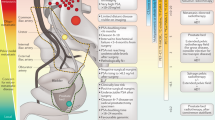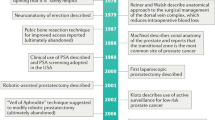Abstract
Prostate cancer has undergone a stage migration since the advent of widespread PSA testing, yet still a significant number of men develop PSA recurrence following radical prostatectomy. This causes anxiety to the patient and the urologist. This review examines the clinical significance of biochemical relapse and the role of imaging modalities and anastomotic biopsies. The importance of the radical prostatectomy pathological features and the PSA kinetics in determining the site of recurrence and the best treatment modality is emphasised. The optimal timing and dose of salvage radiotherapy and the role of hormonal therapy is discussed.
This is a preview of subscription content, access via your institution
Access options
Subscribe to this journal
Receive 4 print issues and online access
$259.00 per year
only $64.75 per issue
Buy this article
- Purchase on Springer Link
- Instant access to full article PDF
Prices may be subject to local taxes which are calculated during checkout
Similar content being viewed by others
References
Han M et al. Era specific biochemical recurrence-free survival following radical prostatectomy for clinically localized prostate cancer. J Urol 2001; 166: 416–419.
Bott SRJ et al. Radical Prostatectomy: pathology findings compared with other major series and over time. Prostate 2002. Liverpool, UK, 2002; Abstract.
Pound CR et al. Natural history of progression after PSA elevation following radical prostatectomy. JAMA 1999; 281: 1591–1597.
Fowler Jr FJ et al. Patient-reported complications and follow-up treatment after radical prostatectomy. The National Medicare Experience: 1988–1990 (updated June 1993). Urology 1993; 42: 622–629.
Lu-Yao GL et al. Follow-up prostate cancer treatments after radical prostatectomy: a population-based study. J Natl Cancer Inst 1996; 88: 166–173.
Freedland SJ, Sutter ME, Dorey F, Aronson WJ . Defining the ideal cutpoint for determining PSA recurrence after radical prostatectomy. Prostate-specific antigen. Urology 2003; 61: 365–369.
Epstein JI, Pizov G, Walsh PC . Correlation of pathologic findings with progression after radical retropubic prostatectomy. Cancer 1993; 71: 3582–3593.
Lange PH et al. The value of serum prostate specific antigen determinations before and after radical prostatectomy. J Urol 1989; 141: 873–879.
Doherty AP et al. Undetectable ultrasensitive PSA after radical prostatectomy for prostate cancer predicts relapse-free survival. Br J Cancer 2000; 83: 1432–1436.
Oesterling JE et al. Prostate specific antigen in the preoperative and postoperative evaluation of localized prostatic cancer treated with radical prostatectomy. J Urol 1988; 139: 766–772.
Pound CR, Partin AW, Epstein JI, Walsh PC . Prostate-specific antigen after anatomic radical retropubic prostatectomy. Patterns of recurrence and cancer control. Urol Clin North Am 1997; 24: 395–406.
Obek C, Neulander E, Sadek S, Soloway MS . Is there a role for digital rectal examination in the followup of patients after radical prostatectomy? J Urol 1999; 162: 762–764.
Cher ML et al. Limited role of radionuclide bone scintigraphy in patients with prostate specific antigen elevations after radical prostatectomy. J Urol 1998; 160: 1387–1391.
Johnstone PA et al. Yield of imaging and scintigraphy assessing biochemical failure in prostate cancer patients. Urol Oncol 1997; 3: 108.
Hricak H et al. Advances in imaging in the postoperative patient with a rising prostate-specific antigen level. Semin Oncol 2003; 30: 616–634.
Harisinghani MG et al. Noninvasive detection of clinically occult lymph-node metastases in prostate cancer. N Engl J Med 2003; 348: 2491–2499.
Connolly JA, Shinohara K, Presti Jr JC, Carroll PR . Local recurrence after radical prostatectomy: characteristics in size, location, and relationship to prostate-specific antigen and surgical margins. Urology 1996; 47: 225–231.
Shekarriz B et al. Vesicourethral anastomosis biopsy after radical prostatectomy: predictive value of prostate-specific antigen and pathologic stage. Urology 1999; 54: 1044–1048.
Saleem MD, Sanders H, Abu EN, El Galley R . Factors predicting cancer detection in biopsy of the prostatic fossa after radical prostatectomy. Urology 1998; 51: 283–286.
Scattoni V et al. Multiple vesico-urethral biopsies following radical prostatectomy: the predictive roles of TRUS, DRE, PSA and the pathological stage. Eur Urol 2003; 44: 407–414.
Foley CL, Bott SRJ, Parkinson MC, Kirby RS . The role of anastomotic biopsy in the evaluation of patients with a rising PSA after radical prostatectomy. British Association of Urological Surgeons Annual Meeting,, 2002.
Koppie TM et al. Is anastomotic biopsy necessary before radiotherapy after radical prostatectomy? J Urol 2001; 166: 111–115.
Scattoni V et al. Biopsy of the vesico-urethral anastomosis after radical prostatectomy: when and how. Eur Urol 2002; 38: 89–95.
Han M et al. Long-term biochemical disease-free and cancer-specific survival following anatomic radical retropubic prostatectomy. The 15-year Johns Hopkins experience. Urol Clin North Am 2001; 28: 555–565.
Han M et al. Biochemical (prostate specific antigen) recurrence probability following radical prostatectomy for clinically localized prostate cancer. J Urol 2003; 169: 517–523.
Anscher MS, Prosnitz LR . Multivariate analysis of factors predicting local relapse after radical prostatectomy—possible indications for postoperative radiotherapy. Int J Radiat Oncol Biol Phys 1991; 21: 941–947.
Nudell DM et al. Radiotherapy after radical prostatectomy: treatment outcomes and failure patterns. Urology 1999; 54: 1049–1057.
Kupelian P et al. Correlation of clinical and pathologic factors with rising prostate-specific antigen profiles after radical prostatectomy alone for clinically localized prostate cancer. Urology 1996; 48: 249–260.
Patel A, Dorey F, Franklin J, deKernion JB . Recurrence patterns after radical retropubic prostatectomy: clinical usefulness of prostate specific antigen doubling times and log slope prostate specific antigen. J Urol 1997; 158: 1441–1445.
Partin AW et al. Evaluation of serum prostate-specific antigen velocity after radical prostatectomy to distinguish local recurrence from distant metastases. Urology 1994; 43: 649–659.
Trapasso JG, deKernion JB, Smith RB, Dorey F . The incidence and significance of detectable levels of serum prostate specific antigen after radical prostatectomy. J Urol 1994; 152: 1821–1825.
Egawa S et al. Limited suppression of prostate-specific antigen after salvage radiotherapy for its isolated elevation after radical prostatectomy. Urology 1999; 53: 148–154.
Cadeddu JA, Partin AW, DeWeese TL, Walsh PC . Long-term results of radiation therapy for prostate cancer recurrence following radical prostatectomy. J Urol 1998; 159: 173–177.
Han M et al. Biochemical (prostate specific antigen) recurrence probability following radical prostatectomy for clinically localized prostate cancer. J Urol 2003; 169: 517–523.
Gervasi LA et al. Prognostic significance of lymph nodal metastases in prostate cancer. J Urol 1989; 142: 332–336.
Diblasio CJ, Kattan MW . Use of nomograms to predict the risk of disease recurrence after definitive local therapy for prostate cancer. Urology 2003; 62: 9–18.
Partin AW et al. Selection of men at high risk for disease recurrence for experimental adjuvant therapy following radical prostatectomy. Urology 1995; 45: 831–838.
Moul JW et al. Predicting risk of prostate specific antigen recurrence after radical prostatectomy with the Center for Prostate Disease Research and Cancer of the Prostate Strategic Urologic Research Endeavor databases. J Urol 2001; 166: 1322–1327.
Losa A et al. Salvage brachytherapy for local recurrence after radical prostatectomy and subsequent external beam radiotherapy. Urology 2003; 62: 1068–1072.
Kiel HJ, Wieland WF, Rossler W . Local control of prostate cancer by transrectal HIFU-therapy. Arch Ital Urol Androl 2000; 72: 313–319.
Ornstein DK et al. Evaluation and management of men whose radical prostatectomies failed: results of an international survey. Urology 1998; 52: 1047–1054.
Tsien C et al. Long-term results of three-dimensional conformal adjuvant and salvage radiotherapy after radical prostatectomy. Urology 2003; 62: 93–98.
Peyromaure M et al. Salvage radiotherapy for biochemical recurrence after radical prostatectomy: a study of 62 patients. Urology 2003; 62: 503–507.
Katz MS et al. Predictors of biochemical outcome with salvage conformal radiotherapy after radical prostatectomy for prostate cancer. J Clin Oncol 2003; 21: 483–489.
Coetzee LJ, Hars V, Paulson DF . Postoperative prostate-specific antigen as a prognostic indicator in patients with margin-positive prostate cancer, undergoing adjuvant radiotherapy after radical prostatectomy. Urology 1996; 47: 232–235.
Grossfeld GD et al. Management of a positive surgical margin after radical prostatectomy: decision analysis. J Urol 2000; 164: 93–99.
Cox JD et al. Consensus statements on radiation therapy of prostate cancer: guidelines for prostate re-biopsy after radiation and for radiation therapy with rising prostate-specific antigen levels after radical prostatectomy. American Society for Therapeutic Radiology and Oncology Consensus Panel. J Clin Oncol 1999; 17: 1155.
Schild SE et al. Radiotherapy for isolated increases in serum prostate-specific antigen levels after radical prostatectomy. Mayo Clin Proc 1994; 69: 613–619.
Peschel RE et al. PSA based review of adjuvant and salvage radiation therapy vs. observation in postoperative prostate cancer patients. Int J Cancer 2000; 90: 29–36.
Van der Kooy MJ, Pisansky TM, Cha SS, Blute ML . Irradiation for locally recurrent carcinoma of the prostate following radical prostatectomy. Urology 1997; 49: 65–70.
Garg MK et al. Impact of postprostatectomy prostate-specific antigen nadir on outcomes following salvage radiotherapy. Urology 1998; 51: 998–1002.
Anscher MS, Clough R, Dodge R . Radiotherapy for a rising prostate-specific antigen after radical prostatectomy: the first 10 years. Int J Radiat Oncol Biol Phys 2000; 48: 369–375.
Valicenti RK et al. The efficacy of early adjuvant radiation therapy for pT3N0 prostate cancer: a matched-pair analysis. Int J Radiat Oncol Biol Phys 1999; 45: 53–58.
Tsien C, Sandler H . Salvage radiotherapy in the treatment of prostate cancer. Urology 2003; 62: 63–68.
The Medical Research Council Prostate Cancer Working Party Investigators Group. Immediate versus deferred treatment for advanced prostatic cancer: initial results of the Medical Research Council Trial. Br J Urol 1997; 79: 235–246.
Messing EM et al. Immediate hormonal therapy compared with observation after radical prostatectomy and pelvic lymphadenectomy in men with node-positive prostate cancer. N Engl J Med 1999; 341: 1781–1788.
Bennett CL et al. Maximum androgen-blockade with medical or surgical castration in advanced prostate cancer: a meta-analysis of nine published randomized controlled trials and 4128 patients using flutamide. Prostate Cancer P Dis 1999; 2: 4–8.
See WA et al. Bicalutamide as immediate therapy either alone or as adjuvant to standard care of patients with localized or locally advanced prostate cancer: first analysis of the early prostate cancer program. J Urol 2002; 168: 429–435.
Wirth MP et al. Prospective randomised trial comparing flutamide as adjuvant treatment versus observation after radical prostatectomy for locally advanced lymph node-negative prostate cancer. Eur Urol 2004; 45: 267–270.
Anderson J . The role of antiandrogen monotherapy in the treatment of prostate cancer. BJU Int 2003; 91: 455–461.
Kolvenbag GJ, Iversen P, Newling DW . Antiandrogen monotherapy: a new form of treatment for patients with prostate cancer. Urology 2001; 58: 16–23.
Author information
Authors and Affiliations
Corresponding author
Rights and permissions
About this article
Cite this article
Bott, S. Management of recurrent disease after radical prostatectomy. Prostate Cancer Prostatic Dis 7, 211–216 (2004). https://doi.org/10.1038/sj.pcan.4500732
Received:
Accepted:
Published:
Issue Date:
DOI: https://doi.org/10.1038/sj.pcan.4500732
Keywords
This article is cited by
-
Detection efficacy of PET/CT with 18F-FSU-880 in patients with suspected recurrent prostate cancer: a prospective single-center study
Annals of Nuclear Medicine (2022)
-
The diagnostic value of PET/CT imaging with the 68Ga-labeled PSMA-ligand in the follow up assessment of prostate cancer after therapy
Egyptian Journal of Radiology and Nuclear Medicine (2020)
-
Pre-test 68Ga-PSMA-ligand PET/CT positivity in early biochemical recurrent prostate cancer after radical prostatectomy—validation of a prediction model
EJNMMI Research (2020)
-
Comparison of 68Ga-PSMA-11 PET/CT with 11C-acetate PET/CT in re-staging of prostate cancer relapse
Scientific Reports (2020)
-
Identification of recurrence marker associated with immune infiltration in prostate cancer with radical resection and build prognostic nomogram
BMC Cancer (2019)



